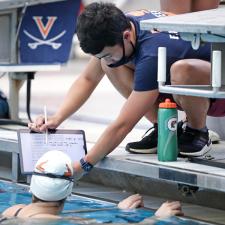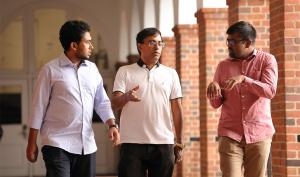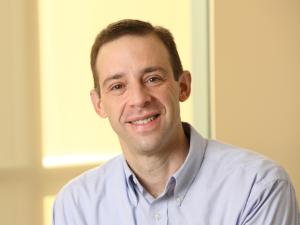News
UVA Engineering's faculty and students work to improve human health and create a sustainable and secure future.
-

Systems Engineering Undergraduate Researcher Is Part of UVA Swimming’s Secret Weapon
Read NowAs an undergraduate research assistant, systems engineering double major Jerry Lu is helping to push UVA swimmers to their highest potential.
-
Environmental Barrier Coating for Jet Engines
Read NowRead Neil Canter's story about UVA post doc Jeroen Deijkers' new duplex bond coating that protects the hottest sections of jet engines with superior thermal stability up to 1,300 C, published online for TLT Tech Beat.
-

‘Beacon of Light’: Outstanding Employee Shows Selfless Dedication and Integrity
Read NowUVA Engineering’s Roland “Ricky” Buchanan, an engineering technician in the Department of Chemical Engineering, has earned UVA’s highest staff honor for dedication and service.
-

UVA Joins Multi-University Team to Design New Class of Semiconductor Materials
Read NowAvik Ghosh joins multi-university initiative to model the physics of materials for infrared opto-electronic systems.
-
New Technology Could Help Doctors Improve COVID-19 Patient Outcomes
Read NowResearchers at the University of Tokyo and University of Virginia find an early and treatable indicator of blood clotting in COVID-19 patients
-
Ph.D. Student Adam Dadey Earns IEEE Photonics Society Top Student Paper Award
Read NowResearch Reveals How Staircase Photodetector Amplifies Signals with Low Noise
-
Good Chemistry Makes Strong Bonds
Read NowChemical Engineering Ph.D. Students and Faculty Have a Culture All Their Own
-

MAE Department Chair Search
Read NowThe Department of Mechanical and Aerospace Engineering (MAE) within the School of Engineering and Applied Science at the University of Virginia invites applications for the position of Department Chair to begin in August 2022.
-

Natasha Sheybani Named to Forbes' 30 Under 30 in Science
Read NowSheybani, an assistant professor in the Department of Biomedical Engineering, was also UVA's first-ever recipient of the prestigious NIH Director's Early Independence Award.
-
We all have a part to play in averting future lead poisoning disasters
Read NowJohn R. Scully, Charles Henderson Chaired Professor of Materials Science and Engineering, and UVA MSE alum Raymond Santucci (Ph.D., '19) explain how electrochemistry impacts clean water availability based on their study of the Flint lead crisis, writing for the UVA Darden Water Blog.
-

Say Goodbye to the Memory Wall
Read NowResearchers in the University of Virginia’s Department of Computer Science and Charles L. Brown Department of Electrical and Computer Engineering are leading a $29.7 million research effort to remove.
-

A Brain Trust Approach
Read NowDecarbonizing heavy freight trucks won’t be easy; no technology today has the power and efficiency to replace diesel engines for moving goods over long distances.